All about planting eggplants outdoors
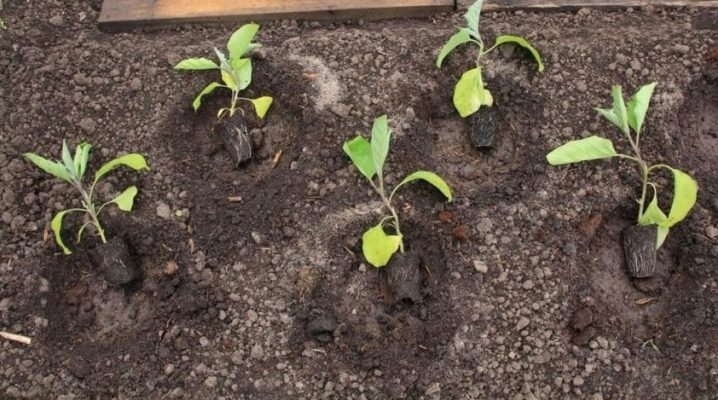
Today, it is possible to grow eggplants outdoors even in the northern regions of Russia. This became possible thanks to selection work and the breeding of cold-resistant varieties. In the article, we will tell you how to grow purple fruits without shelter: how to prepare the soil, in what ways you can plant eggplants, what should be the care of seedlings and how to avoid problematic moments when growing this crop.
Terms and conditions
The cultivation of eggplant requires a special environment and special conditions. Here are some rules that a gardener should pay attention to when planting eggplants outdoors in late spring - early summer.
- Choose only fertile land with a loose soil structure.
- It is necessary to plant seedlings in the ground at a temperature of +20 and above, otherwise the plant will slow down its development.
- Avoid frost: even a short cold snap will negatively affect the culture.
- Daylight hours should last at least 12 hours.
- Provide eggplant bushes with regular watering, otherwise the lack of moisture will have a bad effect on yield: the plant will drop ovaries and buds.
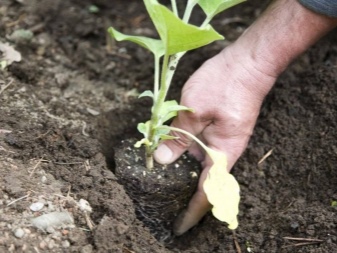
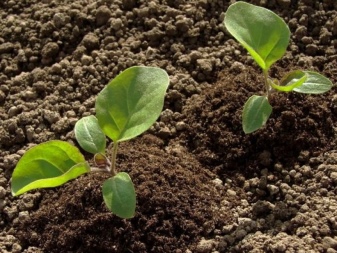
To grow eggplants in Siberia, choose hybrid varieties that are more resistant to cold weather and bear fruit faster:
- "Nutcracker" with small fruits, thick dark skin and fleshy flesh;
- "Robin Hood" with a purple color and elongated fruits.
- "King of the North" with long, relatively thin fruits;
- "Early dwarf" with pot-bellied eggplants.
In the Urals, many manage to grow this crop by planting those varieties and hybrid plants that bear fruit within three months. Where there is a temperate climate, senets are planted in open ground in the first decade of summer.
In warmer conditions, this is done even at the end of spring, when the soil warms up to +18 degrees and it is already clear that there will be no frosts.
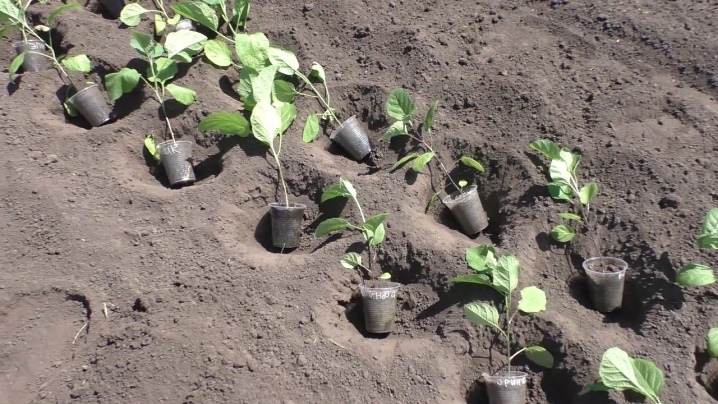
The ways
Eggplant is grown in two ways:
- seedlings;
- seeds.
In the latter case, this is possible only in the southern territories, in regions where the spring-summer period is short, it is impossible for the reason that you can never wait for the growing season.
But even in the southern regions, it is believed that bushes from seedlings will be much stronger. Usually it is grown indoors, then hardened and prepared for transplantation in an open area.

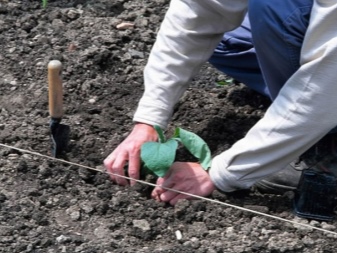
Site selection and preparation
Sandy loam and loamy soils are the best environment for eggplant. The culture also grows on heavier soil - in this case, the beds are prepared in advance. In a garden with heavy soil, it is advisable to do the following work before planting eggplants.
- Add humus and peat composition (one bucket of each component per square meter of eggplant plantation).
- To improve the structure of heavy soils, dilute them with coarse sand extracted from the river environment: 3 buckets of such sand are applied for each square meter.
It is better to prepare any soil in advance.
- In the autumn period, future eggplant beds are dug onto a shovel bayonet.
- Manure is brought under the dug-up reins: in the fall - fresh, in the spring - rotted. The organic composition is added at the rate of: a bucket per square meter.
- In the spring, it is recommended to work on the site with a rake: loosen the ground and level the site.
- To enrich depleted soils, mineral compositions are used in the form of superphosphate and potassium sulfate, as well as urea.The first two components are added 1 tablespoon, and urea - 1 teaspoon per square meter. You can add 2 cups of wood ash powder to this area.

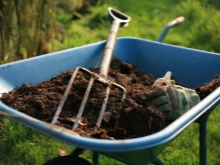
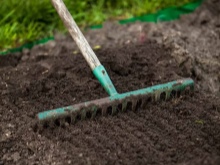
Usually eggplant beds are prepared in the fall, but you can do this a month before planting seedlings. It is desirable to protect the culture from the neighborhood with potatoes, tomatoes, peppers, but next to zucchini, beans, garlic and peas, eggplants will feel comfortable.
How to prepare seedlings?
Young eggplant seedlings are not planted immediately in the ground, otherwise the plants will take root for a long time and may even die. To get a good harvest, the seedlings need to be "adapted" and a number of preparatory measures must be taken.
Hardening
Two weeks before transplanting into open ground, the seedlings begin to harden. This procedure will help young sprouts quickly get used to the cooler climate. Hardening includes the following steps.
- On the first day, the room with the seedlings is ventilated by opening the window. The sash is not closed for half an hour.
- On the second day, they are ventilated for 2 hours.
- On the third day, this time is increased to 4 hours.
- And on day 4-5, the seedlings are taken out on the street and left in the fresh air for 30-45 minutes. In this case, the thermometer should show at least +10 degrees.
- On each subsequent day, boxes or cups with seedlings are left on the street longer and longer, increasing the "walk" of young bushes by several hours every day.

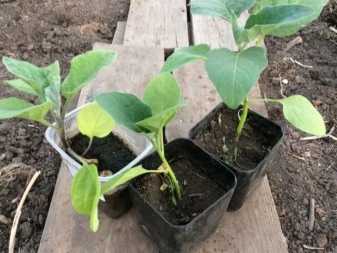
By the time of transplanting to the beds, the seedlings should be in the fresh air around the clock. If you have grown seedlings in an apartment, take them out for hardening on an open balcony. Please note that the sun's rays must also develop "addiction", you can not immediately leave the bushes under direct sunlight.
Top dressing
Before planting in open ground, it is advisable to add fertilizer to the cups with seedlings to feed the plant with useful elements. So the sprouts strengthen their immunity. They become more resilient and resistant to diseases and other negative factors.
Eggplant seedlings are fed 10-15 days before transplanting; for this, one of the proposed methods is chosen.
- For 10 liters of water, take 30 g of potassium salt and 60 g of superphosphate.
- In 10 liters of water, 15 g of yeast are diluted in dry form and left to ferment. After the fermented concentrate is diluted with water in a ratio of 1 to 10 and seedlings in pots are fed.
- 0.5 kg of any greens (grass) is mixed with 1 kg of mullein, 1 tablespoon of ash is added and everything is stirred in a bucket of water. Let it brew for a week and dilute in a ratio of 1: 10 with water.
- A mixture is made from 1 kg of mullein, 500 g of chicken droppings and a glass of ash. Everything is mixed, and when feeding, the composition is diluted with water 1 to 5.
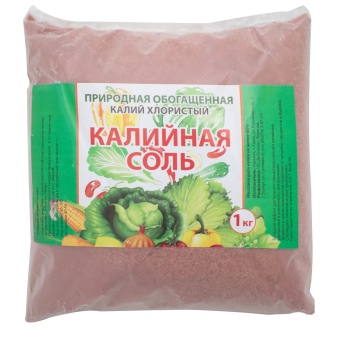
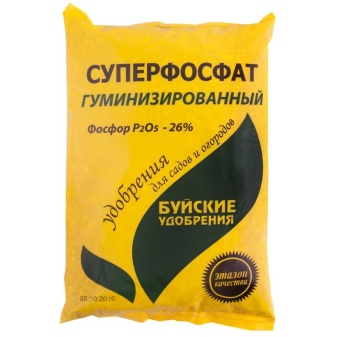
You can also use ready-made fertilizers, use according to the instructions for use. If the seedlings have not shown good growth, add a stimulant to it, while strictly following the standards recommended by the manufacturer.
How to plant correctly?
Planting eggplant seedlings in the garden is carried out when the seedlings have reached the required vegetative stage, while the weather is warm. We will tell you step by step how to plant eggplants in the ground.
- First of all, holes are made in the prepared area: the depth of the holes should allow the powerful root system of the seedling to be kneaded together with the ground. You can also dig relatively deep, the root stem of eggplants grows quite quickly.
- The beds are made at a distance of 60 centimeters from each other, and 30-40 centimeters are left between the bushes. If you are planting spreading varieties, then the distance between the seedlings may be greater.
- Pour 1-2 liters of water into each hole before burying the seedling.
- Plant seedlings in the prepared hole, elongated along with the root and a clod of earth. When transplanting, try not to damage the root system.
- Sprinkle the seedling with earth until the first leaves.
- Compact the soil around the seedling with your hands and mulch. To do this, use peat, straw or dry grass.
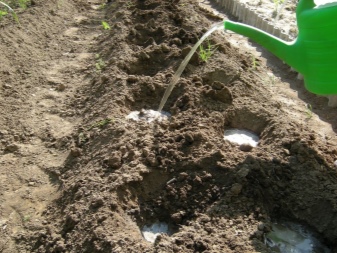
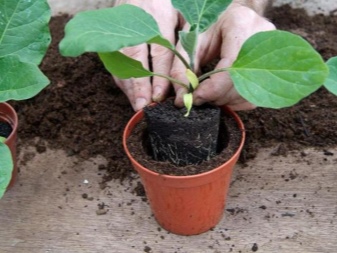
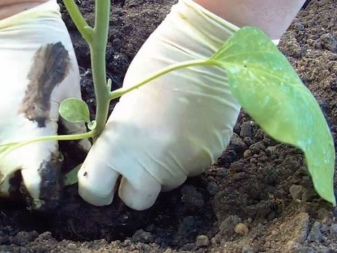
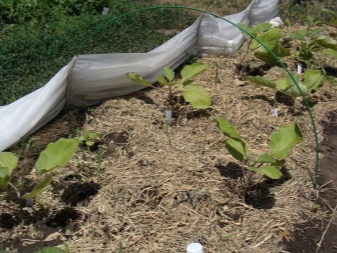
It is better to plant eggplant seedlings in a checkerboard pattern - this way the bushes will grow better without shading each other.
Follow-up care
Eggplant is a rather demanding culture on the growing environment, and growing fruits from the point of view of care is not so difficult. The main thing is to ensure timely watering, fertilize and prevent pests on eggplant plantations.
As for watering, you need to know that this plant belongs to moisture-loving crops. The future harvest and the development of the bush in general depend on the amount of moisture. Learn the following rules.
- Eggplants are poured with exceptionally warm water. In the southern regions it is insisted on the sun, in other areas it is artificially heated up to +25 degrees.
- They use the technology of root watering, but not from above (pouring directly onto the plant is not recommended in order to avoid negative consequences).
- The first time the seedlings are watered after transplanting after 9-12 days, if there is a strong heat outside, then after a week you need to moisten the soil.
- It must be remembered that the root system does not tolerate high humidity, so watering should be moderate.
Increase watering during flowering and ovary formation. During this period, the soil is moistened every 5 days.
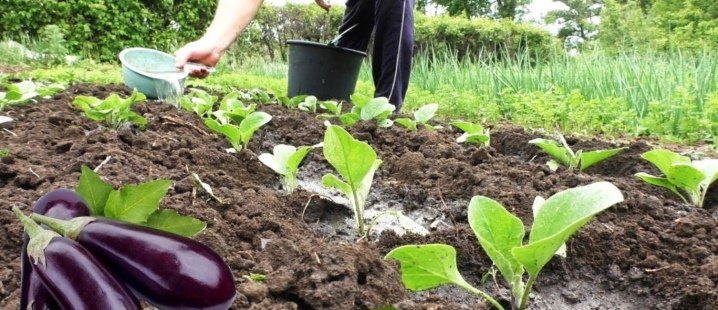
For eggplants to form a rich harvest, top dressing is important. Regular feeding allows you to remove 3-7 kg of fruits from one bush, feeding is done every 15-20 days.
- As soon as the first leaf appears on the seedlings after transplanting, you can feed the plant with nitrogen-containing compounds. Approximately - after 10-12 days of development in the open field. Each bush will need 1-1.5 liters of a solution of such drugs as "Effecton", "Solution", etc. Suitable for the first feeding and ammophos.
- After 14-15 days from the first feeding, you can feed the plants a second time. To do this, take a nitroammophoska or nitrophoska and mix it with wood ash. For each bush, add 20-25 g of the mixture. Instead of this composition, you can insist chicken droppings for 2-3 days, strain, then dilute in warm water and water.
- For the third time, eggplants are fed with nitrophos or diammophos during flowering. For each square meter, take at least 40 g of any composition from the specified list. You can also spray with infusion from fermented herbs or boric acid, having previously dissolved 2 g in 10 liters of well-heated water.


Well, taking into account the fact that harvesting is not limited to 1-2 times, to maintain fruiting, eggplants are fed during this period with fertilizers, which contain phosphorus and potassium. An important point in the care is weeding.
The soil on which the eggplant grows must be constantly loose, so avoid crusting. Continuous weeding will also get rid of weeds and prevent pests from disturbing the plant. They loosen the soil the next day after watering.
The nuances of planting seeds
Eggplant is grown by seeds only in the southern regions. The fact is that this culture is very demanding on climatic conditions, loves warmth and has a long growing season - 100-160 days. Sowing seeds begins when the real warmth has come - for the south, this is the 20th of May.
Before sowing, the seed is calibrated, disinfected and kept in a growth stimulator. The day before sowing, the seeds are left in purified water, and then proceed as follows:
- in the loosened soil, beds are outlined and grooves are made to a depth of 4-5 cm;
- 2-3 seeds are placed in each groove at a distance of 20-25 cm - it all depends on the degree of spreading of the variety;
- sprinkle the seeds with earth and watered well.
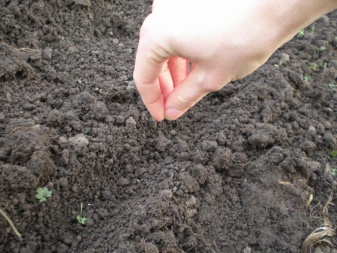

Seedlings will appear in about 6-7 days. When you see the shoots, identify the strongest specimens, remove the rest.
Possible problems
To be able to grow healthy eggplant bushes that will bear fruit the first time, try to avoid the following mistakes.
- Do not water the seedlings abundantly. It is better to cover the soil with mulch - this way the humidity will remain at an acceptable level, but the roots will not suffer from an excess of moisture.
- To transplant the plant, dig in as deep as possible and extract the root with an earthy clod.
- Do not get carried away with nitrogen fertilizers - an overabundance will affect the growth of seedlings: they simply will not stretch.
- In case of frost, it is better to cover the seedlings with plastic wrap.
- Choose the right place for planting and prepare the beds in advance, be sure to decontaminate the soil.
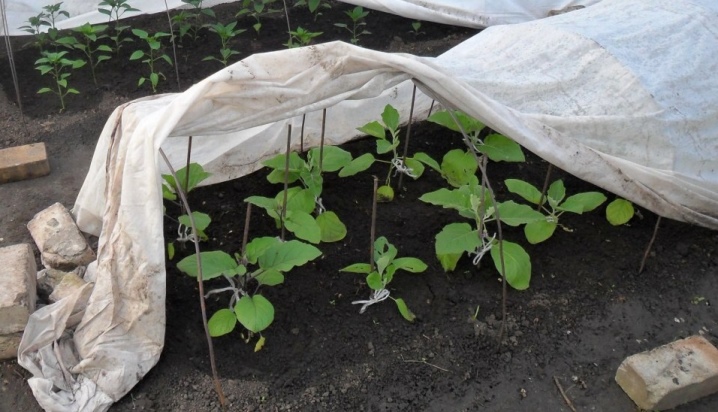
There is no need to ignore a single point of plant care. Eggplant is a rather capricious culture, but it is quite possible to cope with the process of its cultivation. Subject to all agrotechnical standards, even novice gardeners can do this.












The comment was sent successfully.